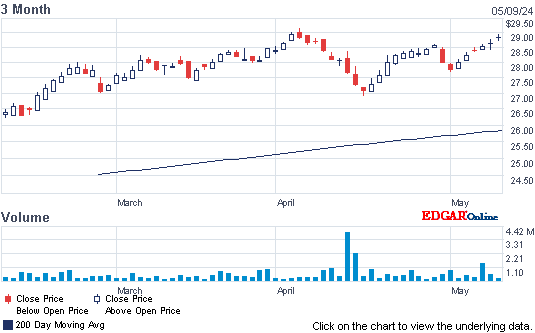Dow shot up 123, advancers over decliners a little better than 3-2 & NAZ added 28. The MLP index went up 2+ to 301 (but still trading sideways for most of the year) & the REIT index gained 1+ to the 334s. Junk bond funds were mixed & Treasuries were sold again, taking the yield on the 10- year Treasury near 5.6%. Oil dropped in the 51s & gold sank a very big 35 as risk averse is embraced by investors.
AMJ (Alerian MLP Index tracking fund)

AMJ (Alerian MLP Index tracking fund)
Light Sweet Crude Oil Futures,F
| 51.50 | -0.59 | -1.1% |
Gold Feb 17
| 1,129.10 | -34.60 | -3.0% |
Confidence among US homebuilders surged in Dec to an 11-year high on prospects the election will translate into a smaller regulatory burden on the industry, according to the National Association of Home Builders/Wells Fargo. Builder sentiment gauge rose to 70 (forecast was 63), the highest since Jul 2005, from 63 (readings below 50 mean more respondents report poor market conditions). Index of prospective buyer traffic rose to 53, also an 11-year high, from 47. Measure of 6-month sales outlook jumped to 78, the best reading since 2005, from 69. The gauge of current sales rose to an 11-year high of 76 from 69. The post-election bounce in sentiment among builders is consistent with other data showing American industries are optimistic Trump will make it easier for companies to do business. While homebuilders in all 4 regions were more upbeat, the backdrop for the industry includes rising mortgage rates & shortages of available lots & skilled workers. “Though this significant increase in builder confidence could be considered an outlier, the fact remains that the economic fundamentals continue to look good for housing,” The NAHB said. “The rise in the HMI is consistent with recent gains for the stock market and consumer confidence. At the same time, builders remain sensitive to rising mortgage rates and continue to deal with shortages of lots and labor.”
Confidence Among Homebuilders in U.S. Surges to an 11-Year High
The cost of living in the US rose for a 4th straight month, adding to signs that inflation is approaching the Fed's goal. The consumer-price index climbed 0.2% in Nov, matching the estimate, after a 0.4% gain the previous month, according to the Labor Dept. Excluding volatile food & fuel, the core measure also rose 0.2% from a month earlier. Rising prices for housing & gasoline contributed the rise in CPI. A sustained acceleration in price gains would increase chances that Fed policy makers fulfill their forecast for 3 interest-rate increases in 2017. The gauge increased 1.7% in the 12 months ended in Nov, the most in 2 years. That follows a 1.6% year-over-year advance the prior month. The core CPI measure's rise follows a 0.1% gain in the previous month. It increased 2.1% from Nov 2015, the same as in the 12 months thru Oct. Expenses for shelter climbed 0.3%, as owners-equivalent rent, one of the categories designed to track rental prices, also rose 0.3%. Energy costs increased 1.2% from a month earlier, the 3rd straight gain, as gasoline rose 2.7%, the report showed. Food prices were unchanged for a 5th month.
Consumer Prices in U.S. Increase for Fourth Consecutive Month
Fewer Americans filed applications for unemployment benefits last week, validating the Fed's view of a vigorous labor market. Jobless claims fell 4K to a 3-week low of 254K, according to the Labor Dept. The estimate called for 255K. Companies are hesitant to dismiss workers as tight labor conditions & steady economic growth place a premium on skilled & experienced employees. Claims have stayed below the 300K level for 93 consecutive weeks, the longest stretch since 1970 & consistent with an improving job market. The 4-week moving average increased to 257K, from 252K. The number of people continuing to receive jobless benefits rose 11K to 2.02M & the unemployment rate among people eligible for benefits held at 1.5%.
Jobless Claims in U.S. Decrease to Lowest Level in Three Weeks
The bulls are back, bidding stocks higher. They figure rate hikes next year will be based on an improving economy which has been stuck around 2% GDP growth for years. Risk is embraced while safe haven investments such as gold & Treasuries are sold to buy stocks. Sounds good until somebody bursts the overbought bubble.
Dow Jones Industrials













No comments:
Post a Comment